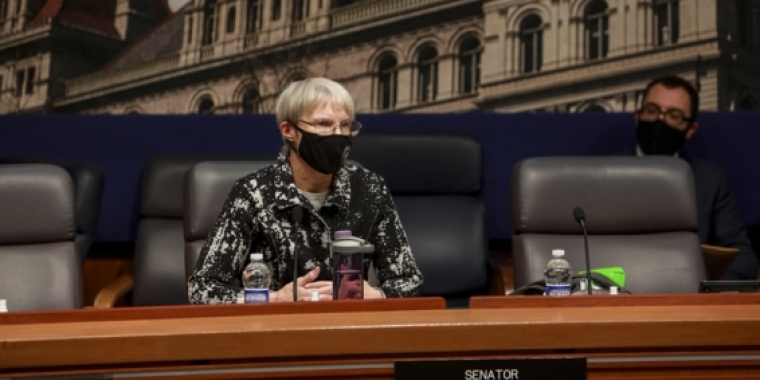Senator May Releases Report on Long-Term Care Hearing
January 6, 2022
-
ISSUE:
- Long-Term Care
-
COMMITTEE:
- Aging

Chairs and members of the Standing Committees on Aging, Health, and Labor of the New York State Senate received spoken and written testimony from stakeholders affected by the long-term care workforce shortage on July 27, 2021.
The eight-hour hearing included more than forty witnesses, including front-line workers, care recipients and their family members, employee unions, managerial and clinical staff, professional and trade associations, senior advocacy groups and grassroots coalitions, legal and academic experts, operators of skilled nursing facilities and assisted living facilities, and home care providers. Fifty written documents were submitted in addition to spoken testimony highlighting the enormous impact of long-term care workforce challenges and offering solutions.
Key Findings include:
1. Workers
For workers, the most pressing issue is inadequate pay and lack of benefits (see section D.1.). Many workers rely on public assistance and lack health insurance despite working full-time or multiple jobs. Other worker issues include:
• Stressful, complex, and high-risk work environments. Compensation does not reflect the skill and occupational risk associated with their roles, and higher wages and hazard pay are warranted.
• Failure to receive full pay for all hours worked. The “24-hour rule” allows workers to be paid for only 13 hours in a 24-hour shift. We also heard reports of wage theft.
• Gaps in employment after a client dies or is hospitalized, resulting in inconsistent hours and fluctuating income.
• A lack of opportunities for career advancement, promotions or raises.
• Excessive caseloads and understaffing in skilled nursing facilities.
• Women, people of color, and immigrants make up the majority of this workforce, so addressing long-term care workforce issues will support gender and racial equity.
2. Employers
For employers, the key issue is New York State’s low Medicaid reimbursement rates (see section D.2))
• New York State Medicaid reimbursement falls well below the cost to provide long-term care.
• Inadequate reimbursement has reduced providers’ ability to offer higher wages for direct care workers. While long-term care worker wages remain at or near minimum wage, wages have increased in other sectors such as fast food that compete with the long-term care sector for workers.
• Responsible budgeting is extremely challenging, as the Medicaid reimbursement rate is set retroactively, sometimes a year late.
• Staffing shortages in home care agencies mean they must turn away as many as 30% of new cases.
• High turnover is costly and time-consuming. Average staff turnover in 2017 and 2018 was 94%; many nursing homes exceed 100% turnover in a one-year period. This requires rehiring and training the entire direct care workforce, including CNAs, LPNs and RNs.
• Many providers reported difficulty retaining managers due to the challenges of navigating shifting COVID-19 guidance, burdensome reporting requirements, and strict enforcement of fines for bureaucratic issues.
3. Care Recipients, Family, and Patient Advocates
For families and patient/resident advocates, the key issue is the need for consistent, reliable care with low turnover (see section D.3.)
• Consistency of care is instrumental to care recipients’ health, quality of life, and independent living, and services.
• The need to find or recruit new caregivers is time-consuming and highly stressful for care recipients and family members.
• Inadequate home care services resulted in preventable health crises for individuals and produced strain for family members required to balance their job or school responsibilities with intensive caregiving roles.
• High turnover among long-term care workers impedes effective communication and collaboration with families.
• Underpaid home care workers are more likely to miss shifts due to transportation or child care issues.
• The fact that many home care workers have to work multiple jobs means they are more likely to contract COVID-19 or other illness and pass on the infection to their clients.
• The Consumer-Directed Personal Assistance Program (CDPAP) is a valuable and effective model for staffing home care
• Training guidelines for long-term care workers are outdated and inconsistent; they do not meet Core Competencies developed by CMS for the direct care workforce.
• Foreign language skills and cultural competencies are needed for long-term care workers to best serve diverse popu-lations across the state.
• The Long-Term Care Ombudsman Program is an important tool for residents and families to register complaints about care at skilled nursing facilities, but it is primarily staffed by a dwindling number of volunteers and needs greater visibility.
related legislation
Share this Article or Press Release
Newsroom
Go to Newsroom

